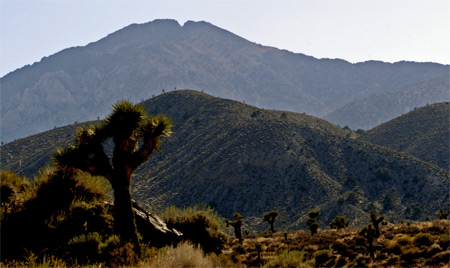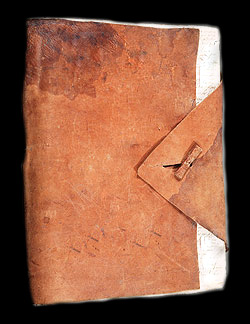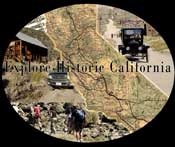It was the cry of gold in the foothills of the western
Sierras echoing across the North American continent that sent
William Lewis Manly & the 49’ers across the treacherous
valley
of
Death
in 1849 to get
to it. Along with the dramatic stories of both death and survival in
that barren valley, legends of gold, lost gunsights and silver were
told as well. Many hearty fortune seekers were lured back to the
valley & surrounding country
in the ensuing years in search of those legends. The list of
names accredited to finding the gunsight mine is
many, as are the tales, and the places as to it’s
whereabouts are as numerous as the list of names, and the tales. Not
only is there confusion as to where the lost mine might be, there is
as much confusion as to what the gunsight was, also.
But I’m not here to tell you the legends and lore of the
past that are so well known. Here
for the first time in print, is the true story of the Lost Gunsight
Mine and how it was found as told to me by a friend of mine.
Pablo
Flores and The Lost Gunsight Mine
It was a brisk night on the mountain, and the wind was
fierce, bringing even brisker temperatures to chill the bones of the
four who sat in the primitive miners cabin. The little pot bellied
stove in one corner, provided some heat, but the nooks and crannies
of the compact cabin couldn’t filter all of the wind out, and the
four huddled close together around the old stove, as the breezes
managed to find their way through them. The roar of the little fire,
and the howling wind beating against the nearly rotten timbers of
the cabin, made it necessary to talk louder than the whisper that
the conversation warranted. Miles of desert nothingness surrounded
the cabin, even at this altitude of 8,000 feet.

Long ago men with names like Benoit, had lumbered out what
few scraggly trees had grown on the cragged hillsides, to burn in
the smelters that processed the ore that had put the mountain on the
map. But the map of the 20th century, barely showed the
place where the four sat hovered before the fire bracing themselves
from the chill and the wind, and few to dared to venture to the
remote spot much any more. There was little danger of anything more
than the mouse who peek-a-booed from a solitary two shelved cabinet
on the wall, hearing what was about to said.
Everyone in the cabin that dark night
had wandered up to the faint remnants of an old Mexican trail
on a long forgotten adventure in search of a dream and come to stay
more than a little while. The cowboy, his ruddy face and blonde hair
well hidden by the hat he always wore, leaned forward in his
crackled paint chair, with a yellowed piece of newspaper in his
rough-hewn hands, and read to the others:
“I’ve had this old paper for some time,” the cowboy
began, “we all know the story about this mountaintop I’ve chosen
to call my home, but it elaborates on it quite nicely. It’s from
the Territorial Enterprise - Virginia City, Nevada
dated way back in May,
1867.
‘We yesterday saw some specimens of ore and silver bullion
that were brought to this city by a Mexican named Bernarda Arambula.
They came from a mountaintop, about forty miles from the camp where
the boys in blue are stationed in Kearsarge Country. The ores shown
us are of the richest character, and came from veins that range in
width from one to four feet. There are said to be hundreds of veins
of a similar character, and only a few of them have been
prospected.
The Mexicans have six small furnaces, and extract silver from the
ore by smelting. The leads are held in common, as are the furnaces,
and each one goes and digs as much ore as he pleases, carries it to
a furnace and smelts it. The furnaces used are very small and
ordinary, being but a foot or two in width, three or four feet long
and five or six high. In all they take out with these six furnaces
about twenty five to thirty pounds of silver per day. Most of this
is sold in rough bars in to which into which it is molded at a small
town called Pine Grove, where they all go to purchase their
provisions. There is but
little coin in circulation, silver bars of various sizes being used
instead. One of the bars shown us weighed six pounds, the other
about one pound.
Bernarda says that the man who first puts up a large and well
constructed furnace at these mines will make a fortune. He brought
the bricks that he extracted to us to this city, in order that by
having them correctly assayed he might find the exact value of the
bullion they are producing. The bars look as well as those produced
here. In this mountain neighborhood, an abundance of pure and
malleable lead is found, as well as significant amounts of zinc, and
a perfect amount of copper ore or astounding richness.
There is quite an excitement among the Mexicans at the north
end of the city about the new mines.”
“Wait a minute…. whose this Bernarda whatever his last
name is, guy? I thought
it was somebody named Pablo that discovered the mines?” one of the
four asked.
“Don’t worry… I’m getting to that,” the cowboy
said, as he reached in the pocket of his heavy suede coat and pulled
out another yellowed newspaper clipping.
“This one comes from the Mining and Scientific press
in December of the same year. I won’t read the whole thing, but
here’s the part about Pablo.”
The cowboy sipped from his tin coffee cup that was just
served him, carefully unfolded the old piece, then continued, “
The first mine discovered here was by Pablo Flores and two other
Mexicans. They started from
Nevada two years ago last March, on a prospecting tour and traveled
southwest over the different ranges of mountains, but did not find
any mineral until they reached this place. After they had satisfied
themselves that there were rich silver and lead mines, here, Pablo
Flores’ two companions started for Virginia City for supplies, and
he remained at the mines.
As they did not return at the appointed time, nor for a long time
afterwards, Flores left, on account of being out of provisions, to
look for them fearing that they might have been killed by the
Indians. he made his way to Virginia City and could learn nothing of
them from his countrymen, and they have not since been seen or heard
of. The Indians no doubt killed them. Flores told his friends about
the discovery of these mines, which induced many of them to come
here with him, and last summer there was quite an immigration of
other Mexicans. During the summer and early fall several Americans
located the mines."
“That’s more like it, that’s the story I know,”
someone said, and the four all nodded their heads in agreement,
“That’s not all there is to the story”, the cowboy
informed them, “Haven’t you wondered what brought them
here….of all the places they could have gone, what guided them to
this particular mountain?
They looked at each other, then one said, “And you think you know
what it was?”
“I don’t think, I know what it was,” and the cowboy stopped
talking and looked at his watch, as a yawn overcame him. “Well,
that’s it for me….we’ve got a long day ahead of us tomorrow,
so I’m turning in.”
He carefully folded his newspaper clippings and put them back
in his coat pocket, then stood up, tipped his hat to his three
friends, then headed out to the door to his own dwelling further up
the steep dirt road.
Dawn the next morning, the four met again at the cabin, and
enjoyed a stout black coffee, and omelets, cooked on the small pot
bellied stove that had struggled to keep them warm the night before.
Silence filled the room while the four nourished themselves.
“Got some work to do at the hoist house today, could sure
use a hand,” the cowboy said, as he wiped a crumb from his mouth
with a paper napkin. “But maybe before we do that we should head
down the back side of the mountain, what do you think?”
and the others noticed a twinkle in his eye as he said it.
Breakfast dishes were piled into a wash pan to be tended to
later, as men often do, and they hurried out to start their day. The
sun was starting to heat up, and the wind was dying down,
thankfully. There was an old Jeep, outfitted with seats for four,
waiting for them. The
cowboy took the driver’s seat, and the others climbed in after
him. He started the engine and slowly meandered up the narrow dirt
road ahead of them. As he got to his own place, a dog ran out to
greet them hoping to go for an adventure. The cowboy stopped for a
brief moment to point the dog back to his place, then proceeded up
the road, past the hoist house, and over the crest of the hill.
There they stopped to enjoy the view of the dry lake bed
below, and towering mountain ranges behind it, then they continued
down a deep ravine that served as road.
The old Jeep maneuvered easily over the pathway that twisted
and turned until it branched off to the east. At this point the four
found themselves in a virtual Joshua tree forest. They abandoned the
Jeep here and set out on foot up a deeply rutted footpath. They
followed it, the cowboy in the lead, until they came to a cabin so
hidden by Joshua trees and giant boulders, that it was obvious to
the others that the cowboy knew it was there.
The cowboy took a swig from a bottle of water, then passed it
around to his friends. His face had a slight grin on it as he
pointed further up the where vegetation refused to grow.

The
sun was shining through a notch in the highest point on the
mountain. One of the
four knew a Kodak moment when he saw it, and lifted his camera to
his eye and began setting up his shot.
The other two followed the cowboy into the cabin.
The door had a padlock on it, and the cowboy had the key.
Inside, the cabin, while the same size as the one they had stayed in
the night before, was better furnished, but
only one person to stay in, as opposed to three. One
wall had a dry kitchen, with rough cabinets that was full of
non-perishables. There was a small wooden table with only one chair,
a cot sized wooden bed minus blankets, a small bookcase with some
reading material, a pot bellied stove, and a large trunk.
Again, the cowboy smiled a knowing smile, as he bent down to
put a key in the large trunk. At first glance it appeared to have
bedding wrapped in plastic, but there
further down was a tiny tin chest, with a tiny padlock on it.
The cowboy searched through his key ring and found the appropriate
key to match it. He made a big production of opening it, adding to
the suspension that thickly filled the cabin. By this time their
fourth companion had walked in the door to join them. A piece of
checkered cloth, perhaps an old napkin, was at the top of the chest
covering the prize inside. The cowboy lifted it, to find a ziplock
bag. He picked up the ziplock bag and held it up for everyone to
see, before he opened it. Inside was a worn leather diary with ink
smudges on the front. Before turning the pages of the diary, the
cowboy looked up at his friends and grinned.
 |
“I came across this broken down cabin a few years back, and
decided I needed a place for a vacation once in awhile to get away
from it all,” and he
laughed, the others joining him. “ I actually use it as a base
camp so I can poke around at some of the old mines on the hill when
I’m alone up here looking for something to entertain me. I was out
hiking around one day when I nearly stumbled into a vertical mine
shaft. Fortunately, I caught my balance just in time.”
and the cowboy laughed again. “
I can’t pass an opportunity to look down an old mine shaft, of
course, even when it nearly consumes me, so I took a peek, and sure
enough there was a pretty sturdy wooden ladder, so I went down it.
I had every intention on going down as far as that ladder
would go, but I hadn’t gone down too far, when I noticed an old
miners lunch pail sort of stuck
between the ladder and the rock wall of the shaft. I pried it lose
from it’s spot, and inside was this diary. I’m not sure how it
kept so dry, and in such good condition, but the way you see it now,
is as it was when I found it.” The diary was passed around and
examined by each of them. The last to receive it gingerly flipped
through the pages as the others had, then turned it back over to the
cowboy.
“I want you to remember that notch in the mountain with the
sun shining through it,” the cowboy winked. There was a long
moment of silence as if he was savoring what he was about to read,
and once again enjoying the anticipation he was building up in his
companions. Then
finally, he opened the diary again, and read from it.
At this point the cowboy stopped reading, although there were
pages more. He walked towards the cabin door and threw it open and
motioned for the others to follow him. When he got to the spot where
they had first viewed the mountaintop with the unusual notch in it
he spread out his arms and grinned ear to ear as Pablo Flores’
friend had, then he
announced in his best Spanish accent, “My dear compadres,......I
too have found the lost gunsight.
Welcome to my mountain!”

My sincerest thanks go to our dear friend, Mike Patterson, who
pointed me down the road that eventually led to the notch in the
mountain and the fabled Lost Gunsight.
Thanks also to my new friend Bob Likes who discovered the
mountain long before I knew of it's existence, and helped me to
understand it's important place in California history.
Bibliography
A
Mine of Her Own-Women Prospectors In The American West, 1850-1950
(chapter
on Ferminia Sarras)
by
Sally Zanjani
University
of Nebraska Press
Lost
Mines of Death Valley
by
Harold O. Weight
The
Calico Press
Twenty-Nine
Palms, California
Cerro
Gordo Bugle of Freedom, Volume
1 Issue 1
Article
quotes from:
Territorial
Enterprise, May 14, 1867
Virginia
City, Nevada
and
Mining
and Scientific Press, December 14, 1867
San
Francisco, CA
Reprinted from Explore
Historic California, April 2006.
